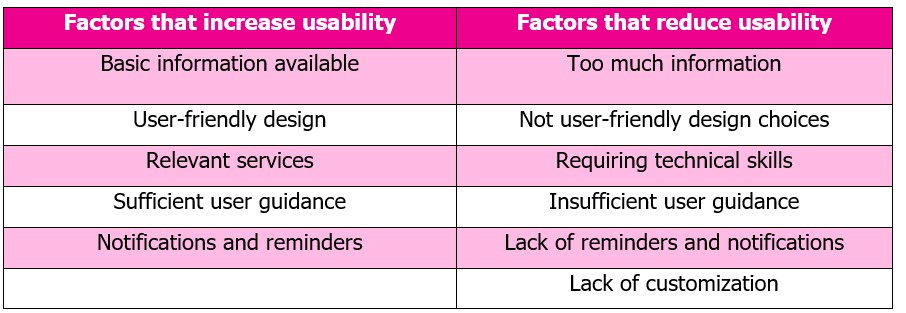
Savonia Article Pro: Usability from the citizens point of view in digital healthcare and social services
Savonia Article Pro is a collection of multidisciplinary Savonia expertise on various topics.
This work is licensed under CC BY-SA 4.0
Easy to use – what does it mean for the citizen user?
Digital services and mobile applications have stormed into our daily lives in various service sectors and the majority of citizens have experiences in using digital services. Many service providers have already dramatically cut down on in-person services and shifted their service offerings more towards digital services. This is easily understandable, as digital services are achievable to most citizens and implementing them cuts down on manual work. Digitalization challenges especially public service vendors to transform their ways of producing services (Rust & Kannan 2002, 3, 235).
Quite quickly after the user starts to use the digital service, they form an opinion if they like the service or not. In healthcare and social services the expectations for digitalization and digital services are extremely high. Digital services are taken rapidly into use, with the aim to achieve better cost-efficiency. Digital services are especially hoped to promote higher self-management in citizens so that they can better maintain health and wellbeing (Ministry of Social Affairs and Health 2023, 10-21). Citizens want to use digital services, but if they lack usability people tend to dismiss them.
What increases usability in digital healthcare and social services?
The narrative literature review that aimed to answer this question showed that the most important usability increasing factor (Table 1.) for the citizen was that the service offered basic information easily, in a non-medical understandable language and in different ways, such as in dynamic or interactive elements (Bondre et al. 2022, 11; Păsărelu et al. 2023, 10-11).
Citizens strongly correlated the digital services good usability to its utility and usefulness in offering relevant content in one service to match their needs. Increased usability was stated when the digital service included case management that guided the user to the appropriate service, solution or professional (Bondre et al. 2022; Brooks et al. 2023a, 13).
More common, typical, and not service segment -related usability increasing factors were the regularly given notifications and reminders and user-friendly design choices, such as aesthetic user interfaces that were easy to use (Raghunath et al. 2020, 426; Hentati et al. 2021, 7; Shi et al. 2021, 4.)
What reduces usability in digital healthcare and social services?
The research identified that usability reduced (Table 1.) most commonly due to the service being difficult to use, unappealing and repetitive. Findings also included technical usability reducing factors if the users experienced issues in using the service, acquiring it or if the correct use of the service required technical understanding from the user. (Shi et al 2021, 4; Bondre et al. 2022, 15.)
Citizen users also reported insufficient user guidance, lack of customization opportunities and lack of reminders and notifications to reduce usability. Citizens experienced feelings of exhaustion and being overwhelmed if the service offered too much information at once, in text form and including medicalized terms. (Hentati et al. 2021, 7; Brooks et al. 2023, 11)

Conclusions
Usability in digital healthcare and social services relates strongly to the services perceived usefulness and utility. Digital services can only achieve their goals if they bring value to the citizen and the service provider, and they are designed to match the user segments needs. The only way to truly know if the service meets these requirements is through usability evaluations and testing. Qualitative usability studies that focus on sample groups that contain real service users can offer valuable insights on what factors reduce usability and what are the needs of the user segment that the service is designed for. Special focus on digital healthcare and social services targeted for the citizens should be in offering clear and understandable information and in designing the service to guide the user to the correct service. The citizen does not need to know what structural processes and organization hierarchies lie behind the service that they need.
This article is based on Eveliina Hotanen’s Master’s Thesis. Read the whole thesis from Theseus
https://urn.fi/URN:NBN:fi:amk-202404106230
Authors:
Eveliina Hotanen, student in Master’s Degree Programme in Digital Health, Savonia University of Applied Sciences
Elisa Snicker, Lecturer, CBC, MSc (Econ and Bus Admin), MSc (Health Sci.), Savonia University of Applied Sciences, Unit of Continuous Learning, Master School, Kuopio
Liisa Klemola, Lecturer, PhD, Savonia University of Applied Sciences, Unit of Continuous Learning, Master School, Kuopio, Finland
References:
Bondre, Ameya P., Shrivastava, Ritu, Raghuram, Harikeerthan, Tugnawat, Deepak, Khan, Azaz,
Gupta, Snehil, Kumar, Mohit, Mehta, Urvakhsh Meherwan, Keshavan, Matcheri, Lakhtakia, Tanvi,
Chand, Prabhat Kumar, Thirthalli, Jagadisha, Patel, Vikram, Torous, John, Rozatkar, Abhijit R.,
Naslund, John & Bhan, Anant 2022. A qualitative exploration of perceived needs and barriers of
individuals with schizophrenia, caregivers and clinicians in using mental health applications in
Madhya Pradesh, India. SSM – Mental Health 2 (100063), 1-17.
https://doi.org/10.1016/j.ssmmh.2022.100063. Accessed 23.2.2024.
Brooks, Helen, Irmansyah, Irmansyah, Syarif, Armaji Kamaludi, Pedley, Rebecca, Renwick, Laoise,
Rahayu, Atik Puji, Manik, Christa, Prawira, Benny, Hann, Mark, Brierley, Helen, Lovell, Karina & Bee
Penny 2023a. Evaluating a prototype digital mental health literacy intervention for children and
young people aged 11–15 in Java, Indonesia: a mixed methods, multi-site case study evaluation.
Child and Adolescent Psychiatry and Mental Health 17 (79), 1-17. https://doi.org/10.1186/s13034-
023-00608-9. Accessed 23.2.2024.
Hentati, Amira, Forsell, Erik, Ljótsson, Brjánn, Kaldo, Viktor, Lindefors, Nils & Kraepelien, Martin
2021. The effect of user interface on treatment engagement in a self-guided digital problem-solving
intervention: A randomized controlled trial. Internet Interventions 26 (100448), 1-9.
https://doi.org/10.1016/j.invent.2021.100448. Accessed 14.3.2024.
Ministry of Social Affairs and Health 2023. Strategy for digitalization and information management in
healthcare and social welfare. Internet publication. http://urn.fi/URN:ISBN:978-952-00-9889-6.
Accessed 17.12.2023.
Păsărelu, Costina-Ruxandra, Kertesz, Reka & Dobrean, Anca 2023. The development and Usability of
a Mobile App for Parents of Children with ADHD. Children 10 (164), 1-13.
https://doi.org/10.3390/children10010164. Accessed 10.3.2024.
Raghunath, Nisha, Dahmen, Jessamyn, Brown, Katelyn, Cook, Diane & Schmitter-Edgecombe,
Maureen 2020. Creating a digital memory notebook application for individuals with mild cognitive
impairment to support everyday functioning. Disability and rehabilitation: Assistive technology 15
(4), 421-431. https://doi.org/10.1080/17483107.2019.1587017. Accessed 10.3.2024.
Rust, Roland T. & Kannan, P. K. 2002. E-Service: New Directions in Theory and Practice. New York:
Taylor & Francis Group. https://ebookcentral-proquest-
com.ezproxy.savonia.fi/lib/savoniafi/detail.action?docID=302437. Accessed 16.12.2023.
Shi, Jenny, Lo, Brian, Wong, Howard W., Hollenberg, Elisa, Sanches, Marcos, Abi-Jaoudé, Alexxa,
Chaim, Gloria, Cleverley, Kristin, Henderson, Joanna, Johnson, Andrew, Levinson, Andrea, Pham,
Quynh, Robb, Janine, Voineskos, Aristotle & Wiljer, David 2021. Assessing the usability and user
engagement of Thought Spot – A digital mental health help-seeking solution for transition-aged
youth. Internet Interventions 24 (100386), 2-10. https://doi.org/10.1016/j.invent.2021.100386.
Accessed 14.3.2024.